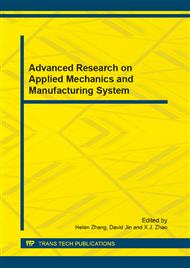[1]
Little JDC, Aggregate advertising models: The state of the art. Operations Research, vol.27, no.4, pp.629-667, 1979.
DOI: 10.1287/opre.27.4.629
Google Scholar
[2]
Pauwels K, How dynamic consumer response, competitor response, company support, and company inertia shape long-term manufaturing system effectiveness. Marketing Science, vol.23, no.4, pp.596-610, 2004.
DOI: 10.1287/mksc.1040.0075
Google Scholar
[3]
Luo X, Quantifying the long-term impact of negative word of mouth on cash flows and stock prices. Marketing Science, vol.28, no.1, pp.148-165, 2009.
DOI: 10.1287/mksc.1080.0389
Google Scholar
[4]
Bronnenberg BJ, Mahajan V, Vanhonacker WR, The emergence of market structure in new repeat-purchase categories: The interplay of market share and retailer distribution. Journal of Marketing Research,vol.37, no.1, pp.16-31, 2000.
DOI: 10.1509/jmkr.37.1.16.18723
Google Scholar
[5]
Mendez-Monroy P, Benitez-Perez H, Supervisory fuzzy control for networked control systems. ICIC Express Letters, vol.3, no.2, pp.233-238, 2009.
DOI: 10.23919/ecc.2009.7074424
Google Scholar
[6]
Pauwels K, Hanssens DM, Siddarth S, The long-term effects of price promotions on category incidence, brand choice, and purchase quantity. Journal of Marketing Research, vol.39, no.4, pp.421-439, 2002.
DOI: 10.1509/jmkr.39.4.421.19114
Google Scholar
[7]
Nijs VR, Dekimpe MG, Steenkamp J, Hanssens DM, The category-demand effects of price promotions. Marketing Science, vol.20, no.1, pp.1-22, 2001.
DOI: 10.1287/mksc.20.1.1.10197
Google Scholar
[8]
Basha R, Ameen J, Unusual sub-sequence identifications in time series with periodicity. International Journal of Innovative Computing, Information and Control, vol.3, no.2, pp.471-480, 2007.
DOI: 10.1109/icicic.2007.336
Google Scholar
[9]
Maxham III JG, Netemeyer RG. A longitudinal study of complaining customers' evaluations of multiple service failures and recovery efforts. The Journal of Marketing, vol.66, no.4, pp.57-71, 2002.
DOI: 10.1509/jmkg.66.4.57.18512
Google Scholar
[10]
Smith AK, Bolton RN, Wagner J. A model of customer satisfaction with service encounters involving failure and recovery. Journal of Marketing Research, vol.36, no.3, pp.356-372, 1999.
DOI: 10.1177/002224379903600305
Google Scholar
[11]
Nijs VR, Srinivasan S, Pauwels KH, Retail-price drivers and retailer profits. Marketing Science , vol.26, no.4, pp.473-487, 2007.
DOI: 10.1287/mksc.1060.0205
Google Scholar
[12]
Dekimpe MG, Hanssens DM, Sustained spending and persistent response: A new look at long-term marketing profitability. Journal of Marketing Research, vol.36, no.4, pp.397-412, 1999.
DOI: 10.1177/002224379903600401
Google Scholar
[13]
Pauwels K, Hanssens DM, Performance regimes and marketing policy shifts. Marketing Science, vol.26, no.3, pp.293-311, 2007.
DOI: 10.1287/mksc.1060.0267
Google Scholar
[14]
Sun XM, Zhao J, Wang W, Two design schemes for robust adaptive control of a class of linear uncertain neutral delay systems. International Journal of Innovative Computing, Information and Control, vol.3, no.2, pp.385-396, 2007.
Google Scholar


